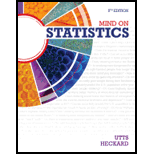
Concept explainers
(a)
To identify: The population of the study.
(a)
Answer to Problem 12.1E
The population will be all babies.
Explanation of Solution
Given information:
The proportion of babies born during FM is 1/29.53.
Concept used:
The whole collection or group of all the elements is known as the population. The sample is the group of elements that are collected from the population and has similar characteristics to the population.
In this case, a study is conducted to identify the proportion of babies born during FM. The results suggest that 1/29.53 of the babies were born during FM.
In this case, the population of the study will be all babies as the study is done to know about the birth of all the babies. Hence, the population of the study will be all babies.
(b)
To find: The population parameter.
(b)
Answer to Problem 12.1E
The population parameter of interest is here the proportion of babies that are born between the period of FM day.
Explanation of Solution
The value measured from the sample is defined as the statistic and the value that is measured from the population is defined as the parameter.
In this case, a study is conducted to identify the proportion of babies born during FM. The results suggest that 1/29.53 of the babies were born during FM. As the researcher is interested to know the proportion of babies born during the period of FM day.
Thus, the population parameter of interest is here the proportion of babies that are born during the period of FM day.
(c)
To write: The hypothesis of interest using the notation.
(c)
Answer to Problem 12.1E
Explanation of Solution
Concept used:
The null hypothesis is the statement that includes equality and it is the assumption about the population.
Here, the study is conducted to identify the proportion of babies born during FM. The results suggest that 1/29.53 of the babies were born during FM. As the researcher is interested to know about the proportion of babies born between the period of FM day, the null hypothesis can be written as:
Here, p is the proportion of babies born during FM.
Thus, the desired answer is
Want to see more full solutions like this?
Chapter 12 Solutions
Mind on Statistics
- Algebra & Trigonometry with Analytic GeometryAlgebraISBN:9781133382119Author:SwokowskiPublisher:Cengage
 Holt Mcdougal Larson Pre-algebra: Student Edition...AlgebraISBN:9780547587776Author:HOLT MCDOUGALPublisher:HOLT MCDOUGAL
Holt Mcdougal Larson Pre-algebra: Student Edition...AlgebraISBN:9780547587776Author:HOLT MCDOUGALPublisher:HOLT MCDOUGAL

